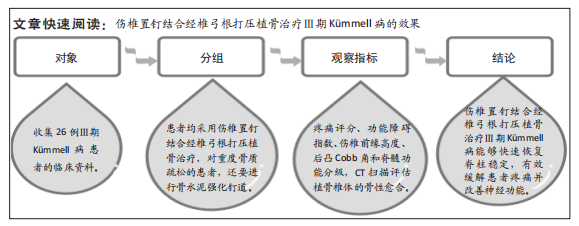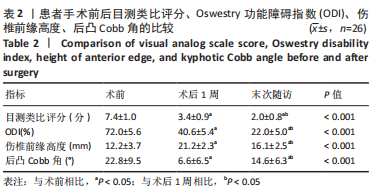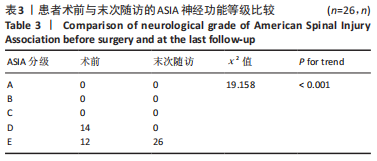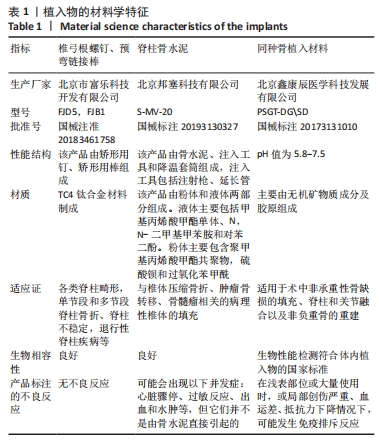中国组织工程研究 ›› 2024, Vol. 28 ›› Issue (18): 2865-2870.doi: 10.12307/2024.042
• 骨科植入物 orthopedic implant • 上一篇 下一篇
伤椎置钉结合经椎弓根打压植骨治疗Ⅲ期Kümmell病:快速恢复脊柱稳定
郑雪静1,梅 伟2,朱彦谕3,包肖肖1,张振辉4,王庆德4
- 1河南中医药大学第二临床医学院,河南省郑州市 450046;2郑州人民医院,河南省郑州市 450002;3周口市中心医院骨科,河南省周口市 466099;4郑州市骨科医院脊柱外科,河南省郑州市 450052
Stage III Kümmell’s disease treated with injured-vertebra screw placement combined with transpedicular impaction bone grafting: quick restoration of spinal stability
Zheng Xuejing1, Mei Wei2, Zhu Yanyu3, Bao Xiaoxiao1, Zhang Zhenhui4, Wang Qingde4
- 1Second Clinical Medical College of Henan University of Chinese Medicine, Zhengzhou 450046, Henan Province, China; 2Zhengzhou People’s Hospital, Zhengzhou 450002, Henan Province, China; 3Department of Orthopedics, Zhoukou Central Hospital, Zhoukou 466099, Henan Province, China; 4Department of Spinal Surgery, Zhengzhou Orthopaedics Hospital, Zhengzhou 450052, Henan Province, China
摘要:

文题释义:
Ⅲ期Kümmell病:是Kümmell病经典的三期分型中最严重的的一种类型,表现为骨折椎体后壁不完整,椎体骨发生坏死性塌陷不愈合,对硬膜囊形成缓慢压迫,多数患者无相应的脊髓、神经损伤症状。Ⅲ期Kümmell病的治疗:虽然后路截骨术和后路椎体次全切术都可以充分矫正后凸,彻底神经减压,但对于合并症多的老年人来说手术创伤过大、并发症多、风险高,术后容易出现螺钉松动、植骨塌陷和椎体高度的丢失等问题。因而,此次研究经椎弓根打压植骨旨在减少创伤,重建脊柱稳定,有效地神经减压和矫正后凸畸形。
背景:Ⅲ期Kümmell病的特点是椎体压缩程度高且伴有后壁缺损,患者多为伴有严重骨质疏松症且合并多种内科疾病的老年人,临床上一些手术方式往往风险较高,存在争议。
目的:探讨伤椎置钉结合经椎弓根打压植骨治疗Ⅲ期Kümmell病的临床疗效。方法:回顾性分析在2016年5月至2021年8月收治的Ⅲ期Kümmell病患者行伤椎置钉结合经椎弓根打压植骨治疗的临床资料。比较手术前后患者的疼痛目测类比评分、Oswestry功能障碍指数、伤椎前缘高度、后凸Cobb角和美国脊髓损伤协会(ASIA)脊髓功能分级来评价手术效果;记录患者手术时间、术中出血量及并发症情况;末次随访时根据CT扫描评估植骨椎体的骨性愈合情况。
结果与结论:①共纳入26例患者,其中男7例,女19例;年龄62-81岁,平均(69.7±4.8)岁;随访时间18-60个月,平均(35.1±8.9)个月;平均手术时间及术中出血量分别为133.5 min(100-165 min)、285.3 mL(210-350 mL);②与术前相比,患者在术后1周和末次随访时的目测类比评分及Oswestry功能障碍指数均明显降低;③术后1周平均矫正伤椎前缘高度和后凸Cobb角分别为(9.0±0.7) mm和(16.2±1.0)°,随访期内矫正的高度和角度分别丢失(5.1±0.3) mm和(8.0±0.4)°;④14例(54%)术前ASIA分级为D级的患者在末次随访时均恢复至为E级,CT扫描可见所有患者植骨椎体均实现良好的骨性愈合;⑤共7例(27%)患者发生并发症,2例患者围术期发生坠积性肺炎,2例患者因浅表伤口组织液化延迟愈合,3例患者在随访期内发生内固定邻近节段椎体骨折;⑥提示伤椎置钉结合经椎弓根打压植骨治疗Ⅲ期Kümmell病能够快速恢复脊柱稳定,有效缓解患者疼痛并改善神经功能,是一种可以选择的有效且相对微创的治疗方式。
https://orcid.org/0009-0008-3554-4418 (郑雪静)
中国组织工程研究杂志出版内容重点:人工关节;骨植入物;脊柱;骨折;内固定;数字化骨科;组织工程
中图分类号:




